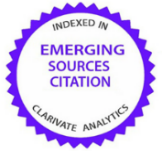Current approaches to the analysis of the borrowers’ creditworthiness: Ukrainian and World experience
Abstract
Introduction. Non-repayment of loans by borrowers not only jeopardizes the profitability of banking structures, but also the ability to calculate them under liabilities - deposit and borrowed funds. This situation is dangerous for the entire banking sector of the country, as it raises a number of acute problems: imbalance of loan and deposit portfolio by volumes and terms; distrust of the population to commercial banks, financial destabilization in the state as a whole, and others like that.
Aim and tasks. The main purpose of this work is to study modern domestic and foreign approaches to assessing the creditworthiness of borrowers.
Results. Based on the analysis of the definitions it is expedient to use the following interpretation of the term "creditworthiness": the financial, economic and legal capacity of the borrower to obtain a loan and return it to the commercial bank in accordance with the terms and conditions of the agreement. At the initial stages of the methodologies developing for the analysis of borrowers' lending, the leading role was played by the coefficient method, which by its nature is considered the simplest and is currently used as an express evaluation and preceded by other research. Currently, almost all commercial banks use a rating approach to assess the borrower's creditworthiness. Such methods also include calculation of coefficients, but contain a predictive component. The rating approach is valuable, because it requires a constant collection of updated information. Often, banks when building credit ratings use the methods of the relevant agencies. It is now believed that the formation of credit ratings allows you to get the most general idea of the borrower's creditworthiness (at the level of the commercial bank) and about the quality of the loan portfolio (at the level of the banking system of the state). Moreover, when assessing the creditworthiness of borrowers – individuals, the rating approach is most often used.
Conclusions. The conducted studies indicate that improving approaches to assessing the creditworthiness of borrowers by commercial banks is particularly relevant for Ukraine. It is important to carry out measures (including administrative) in order to increase the reliability of the input information of borrowers, training of specialized specialists – experts, assessment of qualitative data on the debtor, formation of constantly updated statistical databases, adjustment of methodological developments taking into consideration the variability of the economic situation in Ukraine, ensuring transparency of the analysis, etc.
Keywords:
crediting of the enterprises, financial analysis, evaluation the creditworthiness of the borrower, indexes of the financial state, financial coefficients, quality indexes of solvency.References
2. Barjaktarović L., Paunović M., Ječmenica D. (2013). Development of the Banking Sector in CEE Countries – Comparative Analysis. Journal of Central Banking Theory and Practice, 2, 93-114.
3. Amiti, M., McGuire, P., Weinstein, D. (2016). Supply- and Demand-Dide Factors in Global Banking. BIS Working Papers No 639.
4. Vovchak, O. А., & Meda, N. М. (2013). Modernization of approaches to assessing the creditworthiness of bank borrowers. Bulletin of the National Bank of Ukraine, 12 [in Ukrainian].
5. Kovalchuk, N. O., & Paskar M. O. (2015). Improving methods for assessing the level of creditworthiness of domestic enterprises. Scientific Bulletin of Kherson State University, 11 (1), 91–94 [in Ukrainian].
6. Tchaikovsky, Y. К. (2014). Directions of improvement of the method of analysis of the creditworthiness of the debtor-legal entity. Ukrainian science: past, present, future, 19 (1), 176–188 [in Ukrainian].
7. Vasilchak, S. О., & Demus, L. М. (2012). Evaluation of the borrower's creditworthiness as one of the methods for ensuring the bank's economic security. Scientific Bulletin of NLTU of Ukraine, 22.1, 154–161 [in Ukrainian].
8. Pasternak, A. L. (2012). Models of analysis of borrower's creditworthiness. Journal of KNUTD, 6, 326–330 [in Ukrainian].
9. Vygovskaya, N. G., & Vygovsky, V. G. (2017). Development of methodical tools for assessing the creditworthiness of enterprises taking into account off-balance-sheet risks. Bulletin of the ZhDTU, 4 (82), 111–116 [in Ukrainian].
10. Manzhos, S. B. (2013). Problems of assessing the borrower's creditworthiness in the light of sectoral features. Sustainable development of the economy, 4 (21), 351–356.
11. Ghosh, A. (2015). Banking-industry specific and regional economic determinants of non-performing loans: evidence from US states. J. Financial Stab. 20, 93–104.
12. Galasyuk, V. V. (2001) Assessing the creditworthiness of borrowers: what do we evaluate? Bulletin of the National Bank of Ukraine, 5, 54–56 [in Ukrainian].
13. Bastos, R., & Pindado, J. (2013). Trade Credit During a Financial Crisis: A Panel Data Analysis. Journal of Business Research, 66(5), 614–620.
14. Nikolaidou, E., & Vogiazas, S. D. (2013). Credit risk modelling in the romanian banking system: evidence from an ARDL model. In A. Karasavvoglou, P. Polychronidou (Eds.), Contributions to Economics: Balkan and Eastern European Countries in the Midst of the Global Economic Crisis. Springer.
15. IBI-Rating AGENCY (nd). Retrieved from http://ibi.com.ua/uk/.
16. Rurik (nd). NRA. Retrieved from http://rurik.com.ua/rating-principles/methodology.html.
17. Standard Rating (nd). Retrieved from http://standard-rating.biz/rus/products/.
18. Resolution of the Board of the National Bank of Ukraine On Approval of the Regulation on Determining the Size of Credit Risk by Ukrainian Banks for Active Banking Operations No. 351 (2016, June 30). Retrieved from http://zakon2.rada.gov.ua.
19. National Bank of Ukraine (nd). Class of borrower. Retrieved from https://bank.gov.ua/control/uk/publish/article?art_id=123364.
20. Checkley, K. (2010). Lending techniques. Glasgow.
21. Barasinska, N., & Schäfer, D. (2014). Is crowdfunding different? Evidence on the relation between gender and funding success from a German peer-to-peer lending platform. German Economic Review, 15, 436–452.
22. Rafe, M., & McKee, K. (2017). Consumer Protection in Digital Credit. Focus Note 108, Washington, D.C.: CGAP.
23. Dietrich, A., & Wanzenried, G. (2011). Determinants of bank profitability before and during the crisis: Evidence from Switzerland. Journal of International Financial Markets, Institutions and Money, 21(3), 307–327.
24. Rouz P.S. (1995). Bank management, M.: «Delo».
If the article is accepted for publication in the journal «Economics. Ecology. Socium» the author must sign an agreementon transfer of copyright. The agreement is sent to the postal (original) or e-mail address (scanned copy) of the journal editions.





















